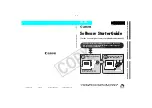
Chapter 1
17
Product Information
Front Panel Components
The Hot-Plug Process
The physical aspect of inserting and removing a disk drive is discussed in the document
that comes with the drive. However, the operating system must be prepared for the
insertion or removal of a disk, or unexpected and harmful effects may occur.
There is a significant difference between the terms “hot-pluggable” and “hot-swappable”.
Hot swapping happens at the device level; that is, a hot-swappable device manages
insertion/removal on its own without assistance from HP-UX commands. The disk drive(s)
in the J6700 are not hot-swappable; they are merely hot-pluggable. Thus, a manual
software procedure must be done in order to safely remove or insert disk drives while the
system is running.
The hot-plug process allows you to replace a defective disk drive in a high-available system
while it is running.
Replacing a Failed Disk Drive
In the context of replacing a failed disk drive, the system administrator must determine
which disk has failed. Depending on how the system was set up, the identity of the failed
drive may or may not be obvious. This determination may be done in either of two ways:
• Tracking the error message written by the LVM (Logical Volume Manager) to the
system console and/or a log file. For information on LVM commands, see the man pages
for
vgchange, lvreduce, vgfgrestore, lvlnboot, lvextend, lvsync,
etc.
• If installed, run the diagnostic utility Support Tool Manager (xstm) to determine disk
malfunction.
The removal of a defective disk drive from an active file system is supported through LVM
commands if hot-pluggable disks have been configured into the HP-UX file system with
LVM. To provide high availability, without impact to users, the disks must also be
configured as mirrored disks. Disk-mirroring is accomplished through use of the
MirrorDisk/UX software (HP part number B2491BA); for information on classes, see
http://www.hgp.com/education/courses/h628s.html
.
No graphical user interface is currently offered through the System Administrator
Manager (SAM) for doing the required LVM commands because manipulation of the LVM
requires specialized knowledge that only experienced system administrators are expected
to have (see below for details).
Summary of Contents for j6700
Page 1: ...Service Handbook HP VISUALIZE J6700 Workstations Manufacturing Part Number n a Edition E0501 ...
Page 8: ...8 Contents ...
Page 30: ...30 Chapter1 Product Information Monitors ...
Page 76: ...76 Chapter3 Troubleshooting Using the System Board LEDs for Troubleshooting ...
Page 100: ...100 Chapter4 Field Replaceable Units FRUs FRU Removal and Replacement ...
Page 134: ...134 Chapter5 Boot Console Handler Initial System Loader ISL Environment ...
Page 150: ...150 Appendix B SCSI Connections How To Connect An SE SCSI Device ...
















































